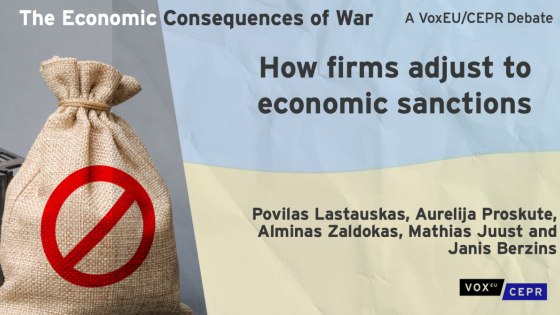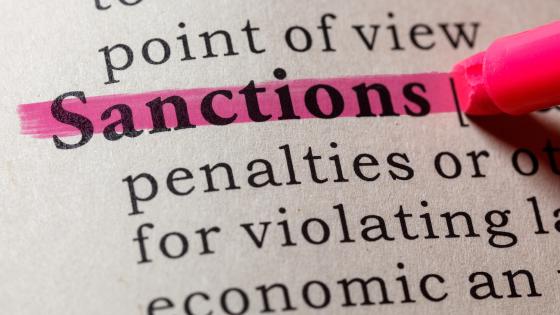In the current turbulent times of geopolitical tensions, deglobalisation, and trade wars, governments are increasingly using economic sanctions and company boycotts to influence each other’s actions. Some of these sanctions directly target selected foreign firms or economic sectors, which consequently experience unanticipated drops in demand for their products and thus have to adjust how they organise their activities. Others are impacted indirectly, through both direct contractual and indirect industrial linkages. In this column, we shed light on the causal impacts of sanctioned economy's adjustment.
Despite the substantial increase in the use of sanctions as political tools, we lack evidence on firm-level reactions to sanctions. This also makes the policy response challenging. We start by reviewing recent literature and international evidence. We then follow with a review of a few recent papers based on the Baltic region. In particular, these papers look at Russian countersanctions on imports from the EU in response to the EU sanctions that were placed on Russia due to the annexation of Crimea in August 2014. This provides a clean natural experiment to derive policy implications as exporters lost access to a significant foreign market due to political reasons unrelated to underlying economic conditions.
Adjustment mechanisms for manufacturers
This particular episode of Russian economic countersanctions, which involved a ban on imports from the EU in August 2014, has previously been analysed from the perspective of its macroeconomic impact by Belin and Hanousek (2019, 2021), Dong and Li (2018), Crozet and Hinz (2016, 2020), and Chowdhry et al. (2022a, 2022b), among others. Similarly, more recent papers by Hausmann et al. (2022) and Latipov et al. (2022a, 2022b) assessed the sanctions that followed the invasion events of 2022.
Beyond quantifying general macroeconomic effects, some other studies have zoomed in on how individual agents such as firms react to sanctions, which helps to better understand and then quantify the mechanisms of shock transmission and understand how they aggregate at the macroeconomic level. For example, when analysing firm adjustment to general trade (demand) shock, Bricongne et al. (2012) find that the size of the firm and the presence of credit constraints are the key defining characteristics of firm adjustment patterns. Haidar (2013, 2017) finds a trade sanctions effect which can be mitigated if firms can engage in trade diversion. In contrast, Crozet and Hinz (2016) find almost no evidence of trade diversion, and no effect from increased partner-country risk or firm size. Instead, Crozet and Hinz (2016) document that firms’ reliance on credit-financed trade was mainly responsible for the decline in trade in both directly and indirectly sanctioned products and firms. Interestingly, Crozet and Hinz (2020) find an increase in country risk affecting international transactions with Russia. In addition, Crozet et al. (2021a, 2021b) highlight the importance of both prior exporting experience in the sanctioned country and specialisation in serving ‘crisis countries’ as additional resistance factors in the face of the trade bans.
Beyond this literature on macroeconomic effects and which firms are able to adjust better, the empirical evidence on the internal adjustment mechanisms of affected firms and the microeconomic foundations of these adjustments is rather scant. To contribute to this, in a recent paper (Lastauskas et al. 2023a), three of us investigate how firms trading embargoed products adjust to the introduction of sudden, unanticipated, and eventually long-lasting economic sanctions (Figure 1 depicts the relative size of the shock). The key adjustment margins include labour and capital adjustments as well as export relocation to other geographic markets. Such adjustments might interact with each other and involve a substantial degree of heterogeneity as firms are subject to non-uniform adjustment costs and expectations of demand shock permanence.
Figure 1 Total exports to Russia by food manufacturing firms
Note: The red lines represent the firms with high pre-2013 exposure of exports to Russia (with exports to Russia constituting over 10% of revenues); the blue lines represent the firms with low pre-2013 exposure of exports to Russia (with exports to Russia constituting 2%–10% of revenues); the green lines represent the average for, respectively, all remaining food manufacturing or wholesale firms in the economy (with exports to Russia constituting less than 2% of revenues).
Using a triple-differences estimator, we analyse product-level (8-digit HS product code) data from the universe of food manufacturers observed over time and merged with the customs data. We consider affected firms to be those that had exports of banned food products to Russia in 2013, and compare firm-level responses between the firms affected by Russia's export ban and the control firms – both in the period after the ban (2014–2017) and in the period before the ban (2011–2013). These control firms are also food manufacturers and exporters of a similar size, i.e. firms engaging in the export of their products to countries outside of Russia. These control firms were thus directly unaffected by Russia's export ban.
We find that following the Russian trade ban, affected food manufacturers experienced an immediate drop in part-time employment, a delayed drop in full-time employment, and a downward adjustment of capital investment. For example, an average exposed firm with a 6.69% pre-ban share of banned export products in its sales reduced its number of part-time employees by 67% compared to the pre-period sample mean, and full-time employees by 6.6% over the pre-shock period average. Affected manufacturers also experienced a drop in investment. At the same time, they saw a rise in exports to the rest of the world, and that effect mitigated the need for employment adjustments. We build a simple model based on Helpman et al. (2010) and find that food manufacturing firms that are quick to reduce their number of part-time employees also later reduce their number of full-time employees and cut investment, i.e. adjustments are complementary rather than substitutional.
Are sanctions only bad news? Distributors and indirectly affected firms
Going beyond direct effects on manufacturers, it is of interest to learn how other companies are impacted due to existing and new relationships with directly affected firms. In a follow-up paper (Lastauskas et al. 2023b), the same three authors demonstrate that a negative impact for food manufacturers directly exposed to embargoed products creates a positive demand effect on trade intermediaries (the wholesaler sector), as can be seen in Figure 2. Those wholesalers that were trading sanctioned products reacted positively to the shock, which stands in contrast to the earlier findings for directly impacted manufacturers. This surprising result comes from the wholesalers' ability to diffuse market entry costs across more export markets and act as a shock absorber for those producers who have been exposed to the sanction shock most, have exhausted other adjustment options, and have limited experience in exporting to alternative markets.
Figure 2 Sales revenues in the two sectors affected by the Russian import ban: Manufacturing (left) and wholesale (right)
Note: The red lines represent the firms with high pre-2013 exposure of exports to Russia (with exports to Russia constituting over 10% of revenues); the blue lines represent the firms with low pre-2013 exposure of exports to Russia (with exports to Russia constituting 2%–10% of revenues); the green lines represent the average for, respectively, all remaining food manufacturing or wholesale firms in the economy (with exports to Russia constituting less than 2% of revenues).
The distinction between wholesalers and producers exporting their products directly is further reinforced by Juust (2021, 2022), who uses Estonian administrative data to investigate how Estonian exporters that had exported non-embargoed goods to Russia in 2013 adapted to the economic shock in the Russian market in 2014–2018. Similar to Lastauskas et al. (2023a), the treated firms consist of all exporters to Russia, whereas control firms are exporters anywhere but Russia during the pre-sanctions period, matched to control firms on firm characteristics such as number of export markets and value-added per employee.
Empirical results confirm that trade effects for firms affected by the Russian demand shock differ for wholesalers and direct exporters, as wholesalers were generally more successful than direct exporters at diverting their trade flows from Russia to other markets. First, the decrease in firm-product level exports was larger for direct exporters than for wholesalers. Second, wholesalers with medium (a 33–66% share of Russia in total pre-shock exports) or high (66–100%) exposure managed to increase their aggregate firm-level exports to markets other than Russia, indicating adaptation through product and market switching.
Even looking at indirectly impacted firms (i.e. those exporting non-embargoed products before the shock), the findings of Juust (2021, 2022) are consistent with those of Lastauskas (2023b), emphasising the importance of well-functioning intermediation to absorb adverse sanctions effects. One additional dimension that Juust (2021, 2022) delves into is productivity – these papers find that, among the firms affected, those with lower initial productivity levels generally experienced larger export contractions. Moreover, export performance after the shock was worse for direct exporters with low productivity than it was for wholesalers with low productivity, again pointing to higher fixed market access costs that need to be borne by producers exporting products directly. This finding lays the foundations for us to suggest a few pieces of policy implications.
A related study examines how adjustment to the demand shock depends on the ownership structure of firms. Berzins et al. (2023) examine the firing practices of private firms in response to a demand shock with an uncertain time horizon by using detailed data on state subsidy support applications to cover unavoidable fixed costs and applications to relieve reduced employment-related costs following the COVID-19 shock in Norway. The results indicate that ownership type significantly influences firm response to the shock. Controlling for firm characteristics, firms with concentrated ownership (family firms) respond to the demand shock by furloughing and firing employees less than firms with dispersed ownership. These firms lessen the overall effect of the demand shock on employment, acting as a buffer in the economy. These findings are consistent with a theoretical reputation model.
Policy implications
Taken together, this combined body of work emphasises the importance of looking at the direct and indirect impacts of unexpected shocks and interventions. Directly impacted firms require a liquidity cushion, flexible labour market regulation, easy access to alternative markets, and support for unavoidable fixed costs. In other words, open economies need even more flexible labour regulations allowing for an array of different work contracts. Another way to view this is from the international perspective: to reduce the impact of sanctions is to pursue policy coordination by easing trade policies for firms from politically aligned countries. Shrinking global trade might require a stronger need for trade redistribution within the alliances.
Moreover, as shown in this column, one way to ease adjustment is to have a well-functioning wholesale sector. Its success is less dependent on productivity considerations, which impact direct traders more strongly. Among the main policy priorities are helping producers to upgrade productivity and diversify modes of accessing foreign markets, including direct and indirect exports.
Authors’ note: The papers on which this column draws were supported by Iceland, Liechtenstein, and Norwaythrough EEA grants (Project No S-BMT-21-8 (LT08-2-LMT- K-01-073)) under a grant agreement with the Research Council of Lithuania.
References
Belin, M and J Hanousek (2019), “Making sanctions bite: The EU–Russian sanctions of 2014”, VoxEU.org, 29 April
Belin, M and J Hanousek (2021), "Which sanctions matter? Analysis of the EU/Russian sanctions of 2014," Journal of Comparative Economics 49(1): 244-257.
Berzins, J, H Gautam, S Miglietta and B Stacescu (2023), “Firm survival and growth in a crisis: Ownership structure, access to finance, and public policies”, CCGR working paper.
Bricongne, J-C, L Fontagné, G Gaulier, D Taglioni and V Vicard, (2012), “Firms and the global crisis: French exports in the turmoil”, Journal of International Economics 87(1): 134-146.
Chowdhry, S, J Hinz, K Kamin and J Wanner (2022a), “Sanctions coalitions: Stronger together”, VoxEU.org, 30 October.
Chowdhry, S., Hinz, J., Kamin, K. and J. Wanner (2022b), “Brothers in arms: The value of coalitions in sanctions regimes”, Discussion Papers of DIW Berlin 2021, DIW Berlin, German Institute for Economic Research
Crozet, M and J Hinz (2016), “Collateral damage: The impact of the Russia sanctions on sanctioning countries' exports”, VoxEU.org, 5 July.
Crozet, M and J Hinz (2020), "Friendly fire: the trade impact of the Russia sanctions and counter-sanctions," Economic Policy 35(101): 97-146.
Crozet, M, J Hinz, A Stammann and J Wanner, (2021b), "Worth the pain? Firms’ exporting behaviour to countries under sanctions," European Economic Review 134(C).
Crozet, M, J Hinz, A Stammann and J Wanner (2021a), “Firms’ exporting behaviour to countries under sanctions”, VoxEU.org, 5 March.
Dong, Y and C Li (2018), "Economic sanction games among the US, the EU and Russia: Payoffs and potential effects," Economic Modelling 73(C): 117-128.
Haidar, J I (2013), “Sanctions and trade diversion: Exporter-level evidence from Iran”, VoxEU.org, 9 April.
Haidar, J I (2017), "Sanctions and export deflection: evidence from Iran," Economic Policy 32(90): 319-355.
Hausmann, R, U Schetter and M A Yildirim (2022), “On the Design of Effective Sanctions: The Case of Bans on Exports to Russia”, CID Working Papers 417, Center for International Development at Harvard University.
Juust, M (2021), "Trade effects of a negative export shock on direct exporters and wholesalers," Bank of Estonia Working Papers wp2021-6, Bank of Estonia, revised 10 Nov 2021.
Juust, M (2022), "Trade effects of a negative export shock on direct exporters and wholesalers", Journal of Economic Studies.
Lastauskas, P, A Proškutė and A Žaldokas (2023a), “How Do Firms Adjust When Trade Stops?”, Bank of Lithuania Working Paper Series No 114.
Lastauskas, P, A Proškutė and A Žaldokas (2023b), “Geopolitical Uncertainties and Trade Intermediaries”, Bank of Lithuania Working Paper Series.
Latipov, O, C Lau, K Mahlstein and S Schropp (2022a), “The latest US tariff sanctions on Russia: A sectoral analysis”, VoxEU.org, 22 August.
Latipov, O, C Lau, K Mahlstein and S Schropp (2022b), “Quantifying the impact of the latest U.S. tariff sanctions on Russia - a sectoral analysis”, Working Papers 2022-08, The George Washington University, Institute for International Economic Policy.










